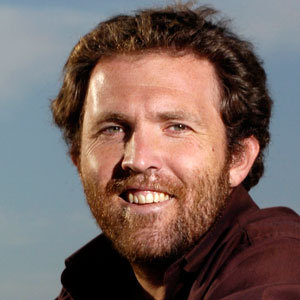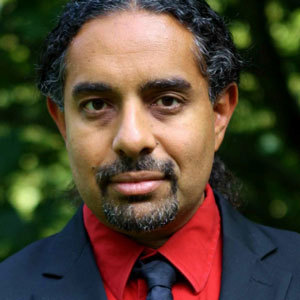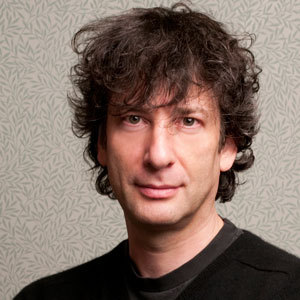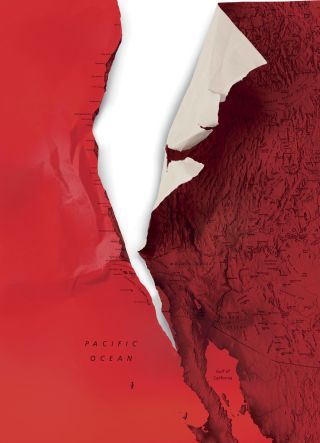Stewart Brand's Blog, page 40
August 14, 2015
Saul Griffith Seminar Tickets
The Long Now Foundation’s monthly
Seminars About Long-term Thinking

Saul Griffith on “Infrastructure and Climate Change”
TICKETS
Monday September 21, 02015 at 7:30pm SFJAZZ Center
Long Now Members can reserve 2 seats, join today! General Tickets $15
About this Seminar:
So far we are trying to deal with climate change at the wrong time scale. A really deep problem cannot be solved by shallow innovations, no matter how clever. The scale of climate change requires thinking and acting in multi-decade terms at the level of infrastructure—personal as well as societal. Get it right, and “the result can be like living in a beautifully managed garden.”
Saul Griffith is an inventor and meta-inventor, currently founder of Otherlabs in San Francisco (devising such things as soft robotics, soft exoskeletons, cheap solar tracking, and conformable gas tanks.) He is a MacArthur Fellow and frequent TED dazzler. His 02009 SALT talk on Climate Change Recalculated is the most viewed video in our twelve-year series.

August 11, 2015
The World’s Languages, Visualized
The South China Morning Post recently published an infographic that colorfully illustrates the distribution of the world’s most commonly spoken languages.
With data taken from Ethnologue and UNESCO, among other sources, the graphic offers a variety of ways to understand global language patterns – from visualizing which languages have the largest number of native speakers, to which country boasts the greatest amount of linguistic diversity.
You can explore the full graphic in all its detail on the South China Morning Post’s website.

August 7, 2015
Ramez Naam Seminar Media
 This lecture was presented as part of The Long Now Foundation’s monthly Seminars About Long-term Thinking.
This lecture was presented as part of The Long Now Foundation’s monthly Seminars About Long-term Thinking.
Enhancing Humans, Advancing Humanity
Wednesday July 22, 02015 – San Francisco
Video is up on the Naam Seminar page.
*********************
Audio is up on the Naam Seminar page, or you can subscribe to our podcast.
*********************
Enhancing humans and humanity – a summary by Stewart Brand
Beginning with the accelerating pace of biotech tools for human health and enhancement, Naam noted that health issues such as disease prevention will be drastically easier to implement than enhancement. Preventing some hereditary diseases can be done with a single gene adjustment, whereas enhancement of traits like intelligence or longevity entails the fine tuning of hundreds of genes. He favors moving ahead with human germline engineering to totally eliminate some of our most horrific diseases.
Over time he expects that human gene editing will lead in the opposite direction from the enforced conformity depicted in Brave New World and the film “Gattaca.” Instead people will relish exploring variety, and the plummeting costs of the technology will mean that the poor will benefit as well as the rich.
Naam’s brain discussion began with the Sergey Brin quote, “We want Google to be the third half of your brain.” Brain interface tools are proliferating. There are already 200,000 successful cochlear implants which feed sound directly into the nervous system. There is a digital eye that feeds pretty good visual data directly to the brain via a jack in the side of the user’s head. There is a hippocampus chip that can restore brain function in a rat.
Rat brains have been linked so that what one rat learns, the other rat knows. The paper on that work was titled “Meta-organism of Two Rats on the Internet.” Humans also have been linked brain to brain at a distance to share function. Zebrafish have been lit up to show all their neurons firing in real time. Coming soon is the deployment of “neural dust” that can provide ultrasonic communications with tens of thousands of neurons at a time.
How profound are the ethical issues? Naam observed that we already have many of the attributes of telepathy in our cell phones and smart phones. They came so rapidly and cheaply that they erased most of the concerns about a “digital divide.” Half of the world is now on the Internet, with the rest coming fast. And rather than a divider, the technology proved to be an equalizer and a connector, fostering economic growth and the rapid spread and sifting of ideas.
Digital connectivity, he argued, is widening everyone’s “circle of empathy.” A viral video started the Arab Spring. Viral videos are changing how everyone thinks about race in America. These technologies, he concluded, are making humans more humane.
One question from the audience inquired about the origin of so much reference in the Nexus series to group meditation as the epitome of mind sharing. Naam noted that Buddhists, including the Dalai Lama, are highly interested in brain science, and his own experiences of the ecstacy of mind sharing were at a rave at Burning Man and a ten-day Vipassana Meditation Retreat in Thailand.
I asked if he agreed with the current round of panic about superintelligent artificial intelligence posing an existential threat to humanity. He said no. The dark scenarios imagine an AI so smart it implements new and grotesquely harmful pathways to solve a poorly contextualized problem. Naam pointed out that “Software almost never does anything well by accident.” (A flock of Tweets burst from the theater with that line.) And the dark scenarios imagine an isolated rogue super-capable AI. In reality nothing really capable is developed in isolation.
Subscribe to our Seminar email list for updates and summaries.

August 5, 2015
Himawari-8 Satellite Offers A New Look at Our Planet – 144 Times Per Day
A sense of perspective is unavoidable from 22,000 miles out. Looking down at Earth from that distance — almost three times farther than the diameter of the planet itself — allows a view of the globe as a massive organic system, pulsing with continuous movement. (NY Times)
Last month, Japan’s new Himawari-8 weather satellite began sending data back to Earth. Launched in late 02014 to help track storm systems and other weather patterns in the Pacific Rim, it looks down on Earth from a geostationary orbit, at about 36,000 kilometers (or 22,000 miles) from the surface.
Its considerable distance from Earth isn’t necessarily surprising; most weather satellites do their work in high earth orbit. But what makes Himawari-8 unique among its colleagues is the fact that it is capable of taking full-color photos of the entire planet. Every day, it sends 144 of these “living portraits” back down to Earth – or one photograph every ten minutes.
With an unprecedentedly high resolution that can visualize features as small as 500 square meters, these images will help scientists better understand the genesis, evolution, and outcome of large-scale weather patterns. But on a broader level, the pictures Himawari-8 sends back can’t help but awaken in us what the Planetary Collective has called the Overview Effect: the combined sense of awe and oneness that seems to come over us all when we see images of the whole Earth, framed by the blackness of space.
The data Himawari-8 produces is meant to help us better grasp the ever-changing, fleeting, and highly localized behavior of the Pacific atmosphere. But it also offers us a reminder to step outside of ourselves and consider the fact that we ultimately inhabit a very small corner of a much larger unit of space and time.

July 31, 2015
Ramez Naam Seminar Media
 This lecture was presented as part of The Long Now Foundation’s monthly Seminars About Long-term Thinking.
This lecture was presented as part of The Long Now Foundation’s monthly Seminars About Long-term Thinking.
Enhancing Humans, Advancing Humanity
Wednesday July 22, 02015 – San Francisco
Audio is up on the Naam Seminar page, or you can subscribe to our podcast.
*********************
Enhancing humans and humanity – a summary by Stewart Brand
Beginning with the accelerating pace of biotech tools for human health and enhancement, Naam noted that health issues such as disease prevention will be drastically easier to implement than enhancement. Preventing some hereditary diseases can be done with a single gene adjustment, whereas enhancement of traits like intelligence or longevity entails the fine tuning of hundreds of genes. He favors moving ahead with human germline engineering to totally eliminate some of our most horrific diseases.
Over time he expects that human gene editing will lead in the opposite direction from the enforced conformity depicted in Brave New World and the film “Gattaca.” Instead people will relish exploring variety, and the plummeting costs of the technology will mean that the poor will benefit as well as the rich.
Naam’s brain discussion began with the Sergey Brin quote, “We want Google to be the third half of your brain.” Brain interface tools are proliferating. There are already 200,000 successful cochlear implants which feed sound directly into the nervous system. There is a digital eye that feeds pretty good visual data directly to the brain via a jack in the side of the user’s head. There is a hippocampus chip that can restore brain function in a rat.
Rat brains have been linked so that what one rat learns, the other rat knows. The paper on that work was titled “Meta-organism of Two Rats on the Internet.” Humans also have been linked brain to brain at a distance to share function. Zebrafish have been lit up to show all their neurons firing in real time. Coming soon is the deployment of “neural dust” that can provide ultrasonic communications with tens of thousands of neurons at a time.
How profound are the ethical issues? Naam observed that we already have many of the attributes of telepathy in our cell phones and smart phones. They came so rapidly and cheaply that they erased most of the concerns about a “digital divide.” Half of the world is now on the Internet, with the rest coming fast. And rather than a divider, the technology proved to be an equalizer and a connector, fostering economic growth and the rapid spread and sifting of ideas.
Digital connectivity, he argued, is widening everyone’s “circle of empathy.” A viral video started the Arab Spring. Viral videos are changing how everyone thinks about race in America. These technologies, he concluded, are making humans more humane.
One question from the audience inquired about the origin of so much reference in the Nexus series to group meditation as the epitome of mind sharing. Naam noted that Buddhists, including the Dalai Lama, are highly interested in brain science, and his own experiences of the ecstacy of mind sharing were at a rave at Burning Man and a ten-day Vipassana Meditation Retreat in Thailand.
I asked if he agreed with the current round of panic about superintelligent artificial intelligence posing an existential threat to humanity. He said no. The dark scenarios imagine an AI so smart it implements new and grotesquely harmful pathways to solve a poorly contextualized problem. Naam pointed out that “Software almost never does anything well by accident.” (A flock of Tweets burst from the theater with that line.) And the dark scenarios imagine an isolated rogue super-capable AI. In reality nothing really capable is developed in isolation.
Subscribe to our Seminar email list for updates and summaries.

July 13, 2015
The Really Big One
On the face of it, earthquakes seem to present us with problems of space: the way we live along fault lines, in brick buildings, in homes made valuable by their proximity to the sea. But, covertly, they also present us with problems of time. The earth is 4.5 billion years old, but we are a young species, relatively speaking, with an average individual allotment of three score years and ten. The brevity of our lives breeds a kind of temporal parochialism—an ignorance of or an indifference to those planetary gears which turn more slowly than our own.
A sobering article detailing the science, infrastructure, and politics behind preparing for a once-a-several-century earthquake from Kathryn Schultz at The New Yorker.

July 9, 2015
World Future Society Conference July 24-26
On July 24-26, the World Future Society’s annual conference WorldFuture 2015: Making the Future will be taking place at the Union Square Hilton in San Francisco. Speakers include Long Now Board Members Peter Schwartz & Paul Saffo and Seminar Speakers Rusty Schweickart & Ramez Naam.
Long Now Members get a 20% discount on tickets on single days & the full conference, please check your email for the discount code for the conference.
Founded in 01966, the World Future Society (WFS) is the longest-running global membership organization for futurists and the foresight minded. Its mission is to improve decision-making about the future by empowering futurists, fostering networks, and advancing knowledge and action on future critical issues.
Every summer, WFS hosts their annual conference, WorldFuture. Designed to bring futurism to the mainstream and introduce a new entrepreneurial generation to the power of foresight, Making the Future reflects the intersection of foresight and action: three days of diverse, interactive sessions designed to unite hundreds of attendees identifying and addressing future-critical issues.. This year, WFS welcomes Long Now Members to join them with special offers, from whole conference discounts to one-day passes and free entry for students living at home for local residents.
The World Future Society Annual Summer Conference
July 24-26, 2015
Union Square Hilton Hotel
worldfuture2015.org

July 8, 2015
Neil Gaiman Seminar Media
 This lecture was presented as part of The Long Now Foundation’s monthly Seminars About Long-term Thinking.
This lecture was presented as part of The Long Now Foundation’s monthly Seminars About Long-term Thinking.
How Stories Last
Tuesday June 9, 02015 – San Francisco
Video is up on the Gaiman Seminar page.
*********************
Audio is up on the Gaiman Seminar page, or you can subscribe to our podcast.
*********************
How stories last – a summary by Stewart Brand
Stories are alive. The ones that last, Gaiman said, outcompete other stories by changing over time. They make it from medium to medium—from oral to written to film and beyond. They lose uninteresting elements but hold on to the most compelling bits or even add some. The most popular version of the Cinderella story (which may have originated long ago in China) has kept the gloriously unlikely glass slipper introduced by a careless French telling.
“Stories,” Gaiman said, “teach us how the world is put together and the rules of living in the world, and they come in an attractive enough package that we take pleasure from them and want to help them propagate.” Northwest coast native Americans have a tale about a beautiful woman and young man whose forbidden love was punished by the earth shaking, and black ash on snow, and finally fire coming from a mountain, killing many people. It stopped only when the beautiful woman was thrown into the burning mountain.
That is important information– solid-seeming mountains can suddenly erupt, and early warnings of that are earthquakes and ash. As pure information it won’t last beyond three generations. But add in beauty and forbidden love and tragic death, and the story will be told as long as people live in the mountains.
The first emperor of China died 2,300 years ago. He was so powerful that he was able to totally conceal the location of his tomb, and all that was left was stories about the fabulous treasures buried with him. There was said to a whole army of terracotta warriors and ships floating on lakes of mercury. A few years ago a terracotta warrior was dug up in a field in China, and then a whole army of them. Archaeologists figured out where the emperor’s mausoleum must be buried, but first they did something not normally done at archeological digs. They checked if there might be any incredibly poisonous mercury around. There is.
Gaiman said he learned something important about stories from his cousin Helen Fagin, a Holocaust survivor who taught class in a Polish ghetto during the Nazi occupation. Books were forbidden on pain of death, but Helen had a Polish translation of Gone With the Wind she read at night, and she told its story to her entranced students by day. “The magic of escapist fiction,” Gaiman said, “is that it can offer you escape from an otherwise intolerable situation, and it can furnish you with armor, knowledge, weapons, and other tools you can take back into your life to make it better.”
“‘Once upon a time,’ Gaiman said, “is code for ‘I’m lying to you.’ We experience stories as lies and truth at the same time. We learn to empathize with real people via made-up people. The most important thing that fiction does is it lets us look out through other eyes, and that teaches us empathy—that behind every pair of eyes is somebody like us.“
Stories have their own form of life, Gaiman concluded. “You can view people as this peculiar byproduct that stories use for breeding and transmission. They are symbiotic with us. They are the thing that we have used since the dawn of humanity to become more than just one person.“
Subscribe to our Seminar email list for updates and summaries.
Photograph of Neil Gaiman by Kimberly Butler

June 29, 2015
Digital Dark Age On The Media
On this week’s episode of On the Media, they dive into the digital preservation issue: what would happen if we, as a species, lost access to our electronic records? What if, either by the slow creep of technological obsolescence or sudden cosmic disaster, we no longer could draw from the well of of knowledge accrued through the ages? What if we fell into…a digital dark age?

June 15, 2015
Neil Gaiman Seminar Media
 This lecture was presented as part of The Long Now Foundation’s monthly Seminars About Long-term Thinking.
This lecture was presented as part of The Long Now Foundation’s monthly Seminars About Long-term Thinking.
How Stories Last
Tuesday June 9, 02015 – San Francisco
Audio is up on the Gaiman Seminar page, or you can subscribe to our podcast.
*********************
How stories last – a summary by Stewart Brand
Stories are alive. The ones that last, Gaiman said, outcompete other stories by changing over time. They make it from medium to medium—from oral to written to film and beyond. They lose uninteresting elements but hold on to the most compelling bits or even add some. The most popular version of the Cinderella story (which may have originated long ago in China) has kept the gloriously unlikely glass slipper introduced by a careless French telling.
“Stories,” Gaiman said, “teach us how the world is put together and the rules of living in the world, and they come in an attractive enough package that we take pleasure from them and want to help them propagate.” Northwest coast native Americans have a tale about a beautiful woman and young man whose forbidden love was punished by the earth shaking, and black ash on snow, and finally fire coming from a mountain, killing many people. It stopped only when the beautiful woman was thrown into the burning mountain.
That is important information– solid-seeming mountains can suddenly erupt, and early warnings of that are earthquakes and ash. As pure information it won’t last beyond three generations. But add in beauty and forbidden love and tragic death, and the story will be told as long as people live in the mountains.
The first emperor of China died 2,300 years ago. He was so powerful that he was able to totally conceal the location of his tomb, and all that was left was stories about the fabulous treasures buried with him. There was said to a whole army of terracotta warriors and ships floating on lakes of mercury. A few years ago a terracotta warrior was dug up in a field in China, and then a whole army of them. Archaeologists figured out where the emperor’s mausoleum must be buried, but first they did something not normally done at archeological digs. They checked if there might be any incredibly poisonous mercury around. There is.
Gaiman said he learned something important about stories from his cousin Helen Fagin, a Holocaust survivor who taught class in a Polish ghetto during the Nazi occupation. Books were forbidden on pain of death, but Helen had a Polish translation of Gone With the Wind she read at night, and she told its story to her entranced students by day. “The magic of escapist fiction,” Gaiman said, “is that it can offer you escape from an otherwise intolerable situation, and it can furnish you with armor, knowledge, weapons, and other tools you can take back into your life to make it better.”
“‘Once upon a time,’ Gaiman said, “is code for ‘I’m lying to you.’ We experience stories as lies and truth at the same time. We learn to empathize with real people via made-up people. The most important thing that fiction does is it lets us look out through other eyes, and that teaches us empathy—that behind every pair of eyes is somebody like us.“
Stories have their own form of life, Gaiman concluded. “You can view people as this peculiar byproduct that stories use for breeding and transmission. They are symbiotic with us. They are the thing that we have used since the dawn of humanity to become more than just one person.“
Subscribe to our Seminar email list for updates and summaries.
Photograph of Neil Gaiman by Kimberly Butler

Stewart Brand's Blog
- Stewart Brand's profile
- 291 followers









